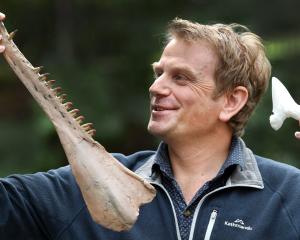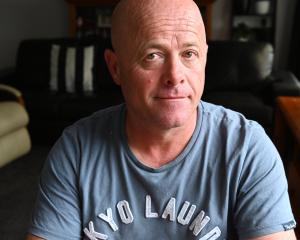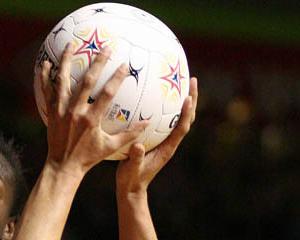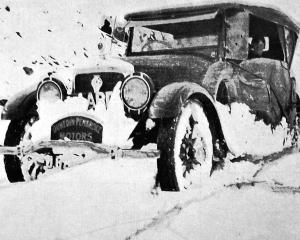
She talks to Rebecca Fox about the role photography can have in public discourse.
The signs say it all, 40 of them lined up precisely on a wall - ‘‘warning toxic algae’’, ‘‘anglers and picnickers beware’’, ‘‘water may contain pollutants’’ repeated over and over.
Each one has been photographed by leading contemporary photographer Anne Noble as she journeyed around Canterbury and Southland with members of Kāi Tahu to capture the state of waterways, past and present, on Kāi Tahu tribal lands.
No stranger to following the journey of rivers - Noble first came to national recognition for her work on the Whanganui River in the 1980s - she was engaged by Te Kura Taka Pini to create an extensive photographic archive of the waterways illustrating not only the devastation of waterways but also the resilience of whānau, hapū, and iwi striving to restore wai Māori, uphold rakatirataka, and protect mahika kai practices.
The photos were used to support Kāi Tahu’s statement of claim before the High Court in Christchurch seeking recognition of Kāi Tahu rakatirataka (authority) over wai Māori, fresh water, within their takiwā (area).
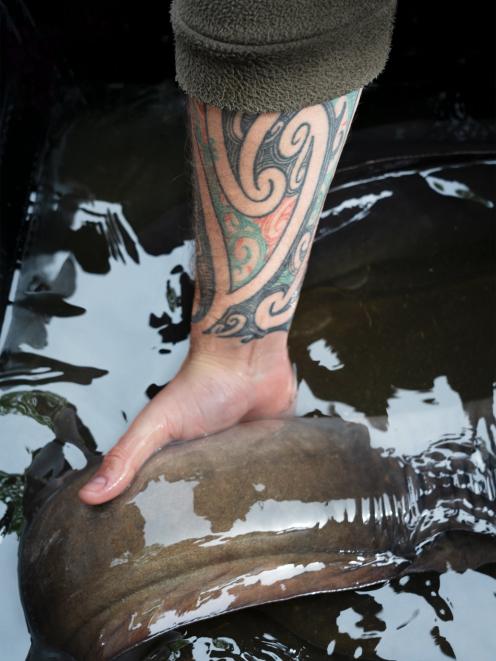
‘‘Rivers are in my blood. The Whanganui project was a very personal story but that’s a lifetime away. Today I’m much more interested in the politics of our relationship to water. There is a conflict between seeing and using rivers as an economic resource and how this impacts on rivers as living entities that are not separate from human and cultural needs and relationships. My hope is that this exhibition can provide a means to think about these things.’’
It was important for Noble to clarify her role in the project as a non mana whenua contributor before she took up the project but she believes photography is a good medium to connect people to places they all inhabit, particularly those affected by various forces of degradation such as the increasing impacts on our waterways of intensive agriculture, forestry, and especially the intensification of dairy, in the South, in Canterbury and Southland.
‘‘Photography is a great medium to insert itself into public discourse. If what the Ngai Tahu claim is wanting to establish is rakatirataka and partnership in managing the health and wellbeing of our waterways, then representation of the impacts of degradation and the impacts on people and their relationships to water is telling everybody’s story. So we’ve worked together on a project that is supporting the Ngāi Tahu Statement of Claim - but it is also a story about water for all of us.’’But she is quick to point out, this is not her story to tell.
‘‘So, I’ve been there, [with] the privilege of seeing with people - through their eyes as it were - to bring something into the public domain. It is important to me that the stories that accompany the photographs are not mine.’’
She has done so in her own way with ‘‘Unutai e! Unutai e!’’ at Dunedin Public Art Gallery by providing the photographs, while members of Kāi Tahu, who were plaintiffs in the High Court case, do the talking through their portraits and their stories of waterway degradation.
For Noble it has highlighted how images of the landscape can often hide a lie.
‘‘People will drive through New Zealand and they’ll see the endless beautiful green. Underpinning the green is another story. The landscapes in this exhibition tell a different story. Yes, and it is not a pretty one.’’
Close-ups of algae blooms and pivot irrigators contrast with aerial views of river and estuary mouths running green.
‘‘These show degradation of water at what are often long-standing traditional mahinga kai sites. So these images point to the impact on mahinga kai customs and practices. All over Canterbury, all over Southland, you can see giant pivot irrigators. Reshaping the landscape. It’s all about turning it green.
‘‘And yet the impact of over-abstraction of water is something that you see evidence of when you visit the estuaries. And there’s not enough flow in the river to turn the stones and clean the river.’’
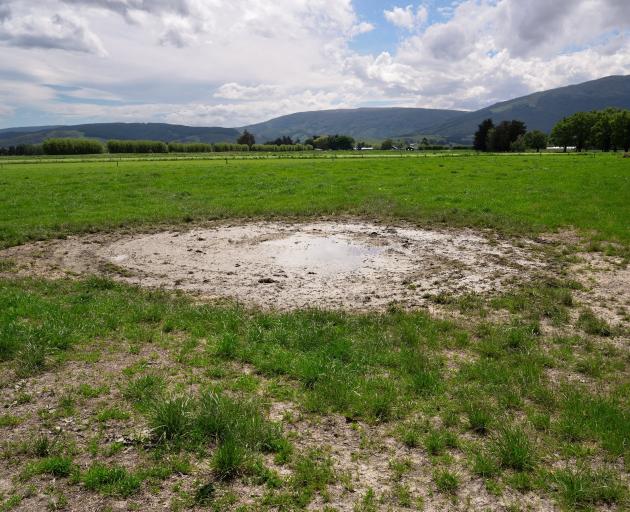
A portrait of Upoko o Kāi Te Ruahikihiki ki Ōtākou Edward Ellison sits beside one of a dry, empty paddock - what was Lake Tatawai, 24 hectares of water where the people who lived at the Māori Kāik (Maitapapa) and Ōtākou settlements would have sought out moulting ducks, īnaka (whitebait) and tuna (eels).
‘‘You’re up to your knees in mud these days, whereas back in the day you could see to the bottom through clear columns of water to gravelly lake and riverbeds,’’ he says in the exhibition label.
She created a collection of signs warning of toxic algae blooms and polluted waters and hung many of them together on one wall. Many were in traditional mahina kai sites.
‘‘This collection of 40 signs is my idea of a landscape. Each of them is a beautiful little individual landscape that just happens to have a toxic water warning sign in the middle of it. All together they are a jolting reminder of what we are doing to our environment.’’
It is her intention for the exhibition to offer an opportunity to stop, encounter the people, the places and, most importantly, the issues that underpin the Ngai Tahu claim for rakatiraka over wai Māori.
‘‘Bring your attention really to things that are overlooked or not seen. The artistry or the concept is to make something that’s inherently ugly incredibly beautiful. And in your then experience of something that is beautiful, yet toxic, is a state of confusion that amplifies something.’’
She points to a close-up image of water flowing over rocks. Look closer and you can see algae growth.
‘‘That would kill your dog.’’
‘‘The role of art is to unsettle and to challenge as well as to uplift. And beauty can be very unsettling. If you look closely at some of these pictures - they are beautiful - but they are of very ugly things. When you’ve been conned, really, by beauty - then you have to go away and think about it, especially when you realise the reality being presented is not beautiful at all.’’

‘‘It’s a famous lake, very important to Ngāi Tahu. What is shown here are the state of three of the many rivers that flow into Te Waihora that all run through intensive dairy country. This lake is ranked as one of the worst in the world in terms of the state of its water.’’
Another photograph shows a person lifting a whitebait net out of the river, basically covered in liquid cow manure.
Given the impact for Kāi Tahu on mahinga kai customs and practices, Noble has given species such as tuna and inanga status and mana by creating ‘‘portraits’’ of them. Alongside are some ‘‘little stories’’ of the science being done to protect species such as a tuna monitoring project at Lake Whakatipu which is trying to understand the impacts on the important traditional food source.
It seemed fitting for portraits of tuna that are abstract and ambiguous to end the exhibition, she says. Being able to amplify the surfaces of the tuna and turn them into a kind of ‘‘magic moment’’ is something only photography can do.
‘‘Their skins are glorious, they’re beautifully slithery, but it’s like light and flashes of light in the water and it’s just turning that into something a little more abstract.’’
Some of the waterway images have been taken on a drone - a first and ‘‘great adventure’’ for Noble, who was excited by the ability it gave her to capture the water from a height even if she was petrified she was going to crash it.
‘‘You get a sense of kind of the scale of things. And when light catches water from above you can see the world in the way that you can’t as a short person with feet on the ground.’’
She is happy to use any tool ‘‘that is the right tool’’ to capture the image she is after. Some images take hours to capture and others she does not know she has captured until she develops them.
‘‘Photographs can be magical accidents. Sometimes you find you have much more in an image than what you actually saw at the time. And then when you recognise that you try and make sense of it and make sure that magic is there for others to find in the picture that you’ve created.’’
The project also came along as Noble retired from teaching photography at Massey University College of Creative Arts, Toi Rauwharangi giving her the opportunity to focus full-time on her own work.
‘‘I’m not afraid of big projects.’’
The archive is a continuation of Noble’s interest in environmental issues from her Antarctic series, mostly developed between 2001 and 2014, to her more recent work In the company of bees and her ongoing project In a Forest Dark.
TO SEE
‘‘Unutai e! Unutai e!’’, Kāi Tahu & Anne Noble, Dunedin Public Art Gallery, Saturday, May 31.
10.30am: Panel Discussion: Ki Uta Ki Tai: What is the future for our wai?
1pm: Exhibition Tour: Join Ōtākou whānau, Te Kura Taka Pini, and members of the Unutai e! Unutai e! working group on a tour of the
exhibition
2.30pm: Performance: He Waka Kōtuia

